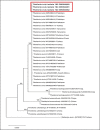Seasonality, epidemiology and phylogeny of Theileria ovis with a note on hematological and biochemical changes in asymptomatic infected goats from Pakistan
- PMID: 37643200
- PMCID: PMC10464961
- DOI: 10.1371/journal.pone.0290620
Seasonality, epidemiology and phylogeny of Theileria ovis with a note on hematological and biochemical changes in asymptomatic infected goats from Pakistan
Abstract
Caprine theileriosis, caused by Theileria ovis is a serious production issue, especially in the areas that depend on goats and sheep for milk, meat, and other economic benefits. Pakistan has a large goat population, but few reports have been documented from this country regarding PCR-based detection of T. ovis. The molecular prevalence of T. ovis, on a seasonal basis, in various goat breeds enrolled from Muzaffar Garh district of Punjab in Pakistan was determined from October 2018 to September 2019. In this study, 1084 goat blood samples were screened for the detection of T. ovis DNA through PCR-based amplification of 18S rRNA gene. Out of 1084 goats, 12 (1.11%) were infected with T. ovis. The parasite prevalence varied with the sampling seasons (Chi square test, P = 0.008), and the parasite prevalence was highest in goat blood samples collected in summer (2.39%) followed by winter (1.88%). DNA sequencing and BLAST analysis confirmed the presence of T. ovis, and the amplified isolates from the 18S rRNA gene of T. ovis were found to be highly conserved during phylogenetic analysis. Young goats (Fischer exact test, P = 0.022) were found more infected with T. ovis during the winter season. Infected goats had elevated white blood cell counts (Two-sample t-test, P = 0.04), blood urea nitrogen to Creatinine ratio (Two-sample t-test, P = 0.02) and decreased serum Creatinine (Two-sample t-test, P = 0.001) as compared to T. ovis negative goats. We report a relatively low molecular prevalence of T. ovis in goats from the Muzaffar Garh district. However, it is recommended that control measures to eradicate T. ovis infection in goats in this area should be taken.
Copyright: © 2023 Irfan et al. This is an open access article distributed under the terms of the Creative Commons Attribution License, which permits unrestricted use, distribution, and reproduction in any medium, provided the original author and source are credited.
Conflict of interest statement
The authors have declared that no competing interests exist.
Figures


References
-
- Riaz M, Nazir MM, Tasawar Z, Ahmed AN, Ayaz MM, Akram Q, et al.. (2019) Molecular epidemiology and prevalence of Theileria lestoquardi and Theileria ovis infection in goats infested with tick vectors from Multan, Pakistan. J Med Entomol. 2019; 56(3):844–848. - PubMed
-
- Zaman MA, Rafique A, Mehreen U, Mehnaz S, Atif FA, Abbas A, et al.. Epidemiological investigation and development of loop mediated isothermal amplification for the diagnosis of ovine theileriosis. Pak Vet J. 2022;42(3):370–375.
-
- Government of Pakistan. Pakistan Economic Survey 2019–2020. Ministry of Finance, Islamabad, Pakistan. 2020;17–41 http://www.finance.gov.pk/survey_1920.html.
-
- Yasein G, Ashraf K, Naveed U, Rashid MI, Shabbir MZ. First genetic evidence of Trypanosoma theileri in indigenous cattle in Southern Punjab province of Pakistan. Pak Vet J. 2022;42(3): 322–327. 10.29261/pakvetj/2022.034. - DOI
-
- AbouLaila M, AbdEl-Aziz AR, Menshawy S, Yokoyama N, Igarashi I, Al-Wabel M, et al.. Evaluation of the inhibitory effects of coumermycin A1 on the growth of Theileria and Babesia parasites in vitro and in vivo. Pak Vet J. 2021;41(4):469–474.
Publication types
MeSH terms
Substances
LinkOut - more resources
Full Text Sources
Research Materials

